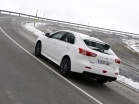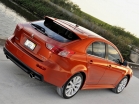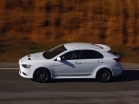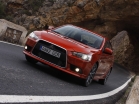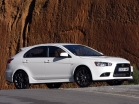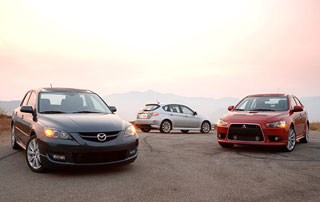technical characteristics of Mitsubishi Lancer Sportback Rallire since 2008 hatchback
Technical characteristics of Mitsubishi Lancer Sportback 2008, 2009, 2010, 2011, 2012, 2013: Power, fuel consumption per 100 km, weight (mass), road clearance (clearance), radius of reversal, type of transmission and brakes, body and tire sizes and tires
Engine characteristics
| Modifications |
Engine volume, cm3 |
Power, kW (lp)/about |
Cylinders |
Twisting, Nm/(rpm) |
Type of the fuel system |
Type of fuel |
| 2.0 MiveC Turbo |
1998 |
177(240)/6000 |
L4, in -line location |
343/2500-4725 |
Distributed injection |
Petrol |
Drive and transmission
| Modifications |
type of drive |
Type of transmission (basic) |
Type of transmission (optionally) |
| 2.0 MiveC Turbo |
4x4 (all -wheel drive) |
6-ACPP SST with double clutch |
|
Brake system and steering wheel amplifier
| Modifications |
Type of front brakes |
Type of rear brakes |
Power steering |
| 2.0 MiveC Turbo |
Disk ventilated |
Disk ventilated |
|
The size of the tires
| Modifications |
Size |
| 2.0 MiveC Turbo |
215/45 R18 |
Dimensions
| Modifications |
Length, mm |
Width, mm |
Height, mm |
The track front/back, mm |
Wheel base, mm |
Road clearance (clearance), mm |
Trunk volume, l |
| 2.0 MiveC Turbo |
4585 |
1758 |
1514 |
|
|
|
391 |
Car weight
| Modifications |
Equipped mass, kg |
Maximum mass, kg |
Lifting capacity, kg |
| 2.0 MiveC Turbo |
|
|
- |
Dynamics
| Modifications |
Maximum speed, km/h |
Acceleration time to 100 km/h, with |
CD (frontal resistance coefficient) |
| 2.0 MiveC Turbo |
220 |
7.1 |
- |
Fuel consumption
| Modifications |
In the city, l/100 km |
On the highway, l/100 km |
Average consumption, l/100 km |
Extrication CO2, g/km |
Type of fuel |
| 2.0 MiveC Turbo |
8.1 |
13.9 |
10.2 |
243 |
Petrol |
Test drives
Comparative Test in the Class Sport Compact
Thanks to three turbines, 724 hp And five differentials of increased friction compare Mazdaspeed 3 (American analogue of Mazda3 MPS), Subaru Impreza Wrx and Mitsubishi Lancer Ralliarit even more fun than watching a fight without rules when the Valuev ring against the duet Smash! Just imagine! One flies from the wall to the wall, and the other shut up ...

